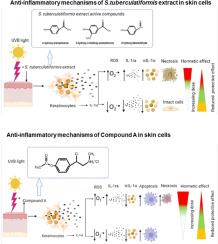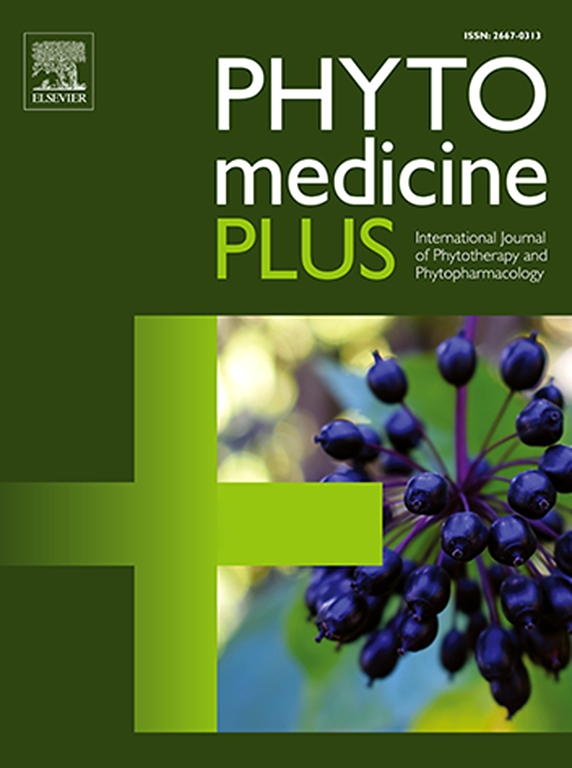Salsola tuberculatiformis Botch 和化合物 A 在紫外线照射皮肤角质细胞中对 IL-1Ra:IL-1α 的不同调节作用中的化学预防潜力
Q3 Pharmacology, Toxicology and Pharmaceutics
引用次数: 0
摘要
背景Salsola tuberculatiformis Botsch,俗称 Gannabos,是纳米比亚的一种灌木,因其在大鼠体内的避孕特性以及在体外和体内调节肾上腺类固醇生成的能力而闻名。由于灌木中的活性化合物具有易变性,因此合成了一种更稳定的合成类似物--化合物 A。这种化合物具有与结节形灌木的原始提取物相似的避孕和类固醇生成特性。此外,化合物 A 还在皮肤中显示出强大的抗炎和抗癌作用,这就提出了结核菌提取物是否也具有类似特性的问题。该研究旨在评估结核菌提取物和化合物 A 的抗炎和抗致癌性,尤其是它们对紫外线诱导的炎症、细胞生长参数和 HaCaT 细胞氧化状态的影响。使用 ELISA 法检测 IL-1α 和 IL-1Ra 的产生,从而评估抗/前炎症作用。此外,研究还通过 ATP 生成监测了细胞活力,通过 Caspase-3 活性监测了细胞凋亡,并使用 DCFDA 分析法监测了氧化应激。结果S. tuberculatiformis 提取物在浓度较低时抑制了 IL-1α 的生成,而在浓度较高时增加了 IL-1Ra。这与细胞活力降低、促氧化剂(ROS)和促炎症活性(细胞内 IL-1α)增加有关。另一方面,化合物 A 通过诱导细胞凋亡降低了 IL-1Ra 和 IL-1α 的水平。然而,在较高浓度下,化合物 A 会显著增加细胞外 IL-1Ra 的水平,并增强促凋亡和促氧化活性。与化合物 A 相比,提取物表现出不同的抗炎作用,细胞内 IL-1Ra:IL-1α 的比率增加就是证明。这些抗/促炎作用可能与伤口愈合有关。化合物 A 通过细胞凋亡和产生 ROS 清除发炎和受损细胞,显示出一种新的间接抗炎作用。化合物 A 的促氧化活性可能是由于氮丙啶的形成,它似乎加快了受损细胞凋亡的进程。本文章由计算机程序翻译,如有差异,请以英文原文为准。

Chemopreventative potential of Salsola tuberculatiformis Botch and Compound A in the differential regulation of IL-1Ra:IL-1α in UVB exposed skin keratinocytes
Background
Salsola tuberculatiformis Botsch, commonly known as Gannabos, is a Namibian shrub known for its contraceptive properties in rats and its ability to modulate adrenal steroidogenesis both in vitro and in vivo. Due to the labile nature of the active compounds in the shrub, a more stable synthetic analogue, Compound A, was synthesized. This compound has demonstrated similar contraceptive and steroidogenic properties as the original extract from S. tuberculatiformis. Additionally, Compound A has shown potent anti-inflammatory and anti-cancer effects in skin, raising the question of whether the S. tuberculatiformis extract might exhibit similar properties.
Purpose
The study aimed to evaluate the anti-inflammatory and anti-carcinogenic properties of S. tuberculatiformis extract and Compound A, particularly their effects on UVB-induced inflammation, cell growth parameters, and oxidative status in HaCaT cells.
Methods
The biological activity of S. tuberculatiformis extract and Compound A was assessed using a cytochrome P450 assay. Anti/pro-inflammatory effects were evaluated by measuring IL-1α and IL-1Ra production using an ELISA assay. Additionally, the study monitored cell viability through ATP production, apoptosis via Caspase-3 activity, and oxidative stress using the DCFDA assay.
Results
S. tuberculatiformis extract inhibited IL-1α production at lower concentrations while increasing IL-1Ra at higher concentrations. This was associated with reduced cell viability and increased pro-oxidant (ROS) and pro-inflammatory activity (intracellular IL-1α). Compound A, on the other hand, reduced IL-1Ra and IL-1α levels by inducing apoptosis. However, at higher concentrations, Compound A significantly increased extracellular IL-1Ra levels and enhanced pro-apoptotic and pro-oxidant activity. The extract exhibited different anti-inflammatory effects compared to Compound A, as evidenced by the increased intracellular IL-1Ra: IL-1α ratio.
Conclusion
The data suggest that S. tuberculatiformis acts as an anti-inflammatory agent at low concentrations by inhibiting intracellular IL-1α production, while at higher concentrations, it regulates pro-inflammatory signaling through IL-1Ra. These anti/pro-inflammatory effects may have potential relevance in wound healing. Compound A displayed a novel indirect anti-inflammatory effect by removing inflamed and damaged cells via apoptosis and ROS production. The pro-oxidant activity of Compound A, potentially due to aziridine formation, appears to accelerate the progression of damaged cells into apoptosis.
求助全文
通过发布文献求助,成功后即可免费获取论文全文。
去求助
来源期刊

Phytomedicine Plus
Medicine-Complementary and Alternative Medicine
CiteScore
3.70
自引率
0.00%
发文量
178
审稿时长
81 days
期刊介绍:
 求助内容:
求助内容: 应助结果提醒方式:
应助结果提醒方式:


